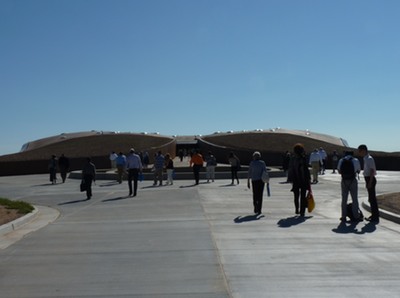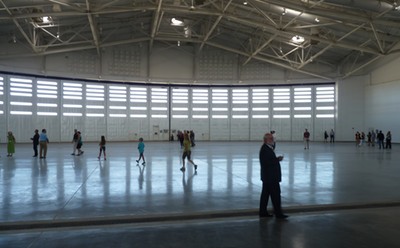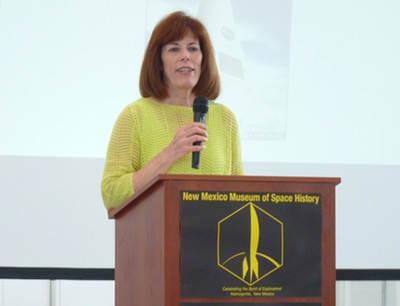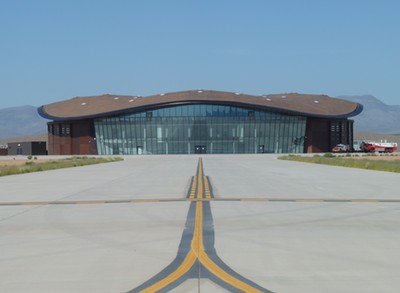Spaceport America awaits liftoffby Jeff Foust
|
| On the outside, at least, the spaceport is ready to start operations for Virgin Galactic. |
The destination of this bus was Spaceport America, an oasis of sorts in this middle of this emptiness. Just as the summer rains brought a splash of green to the desert, officials hope that the spaceport will also provide some green—as in money—for the economy. But nearly two years after the spaceport’s main building was formally dedicated (see “A gateway to space emerges in the desert”, The Space Review, October 24, 2011), the spaceport is still waiting for its anchor tenant to start operations.
On the outside, at least, the spaceport is ready to start operations for Virgin Galactic. The distinctive architecture of the main terminal building, officially known as the “Virgin Galactic Gateway to Space,” looks no less stunning than it did when the building was officially dedicated in October 2011. Stand in the right place on the tarmac, and the curved roofline blends into the skyline of the mountains off to the west.
The building’s main entrance, though, is actually on the other side of the building. Those visiting the spaceport last month for the DC-X 20th Anniversary and Aerospace Workshop got the opportunity to go inside the building, accessed by going up a sidewalk that runs between the two halves of the rear section of the building’s roof, which blends into the landscape. Once inside, a walkway takes people across the top of the hangar to the “astronaut lounge” on the building’s third floor where future Virgin Galactic customers will prepare for their flights.
No photography was allowed inside the building, except for in the hangar itself (which hosted the day’s symposium sessions), but there is in fact little to see in those rooms at the moment. The astronaut lounge is, for now, empty, with bare floors and walls and no furnishing. The same is true for the second floor mezzanine, which will host additional training rooms and mission control; and the first floor departure lounge, where customers will leave the building to board SpaceShipTwo.
 The walkway at the back of the terminal building, leading to the main entrnce. (credit: J. Foust) |
The hangar, big enough to accommodate multiple WhiteKnightTwo and SpaceShipTwo vehicles, is also, for now, empty, which made it a good place to host a symposium (other than poor acoustics that were partially remedied by opening the curved hangar doors on either side.) While part of the day looked back to the past and the development of the DC-X (see “Can lightning strike twice for RLVs?”, The Space Review, August 19, 2013), part of it looked ahead to when the hangar would be filled not with table and chairs, but with spaceplanes.
“We’re in pre-ops right now,” said Christine Anderson, executive director of the New Mexico Spaceport Authority, in a presentation at the August 16th symposium. “We’ve got most of our support staff on board and we’re writing our policies and procedures.”
| “The goal in this is to be totally self-supporting,” Anderson said, and not have to rely on funding from the state for ongoing operations. “We’re now on a very good path to that.” |
The spaceport authority is also working on finish touches of its own to the spaceport. It recently completed a 610-meter (2,000-foot) extension of the spaceport’s runway, to 3,660 meters (12,000 feet), in order to better accommodate SpaceShipTwo landings. It’s also working on plans to pave the road that comes into the spaceport from the south, which will shorten travel times to the spaceport from Las Cruces and El Paso by allowing people to avoid going all the way north to Truth or Consequences before heading east and back south along the current paved road.
“The goal in this is to be totally self-supporting,” she said, and not have to rely on funding from the state for ongoing operations. That funding, she said, will primarily come from fees from spaceport operations, as well as from tourism; the spaceport has also earned some money from advertising and sponsorship opportunites, such as a publicity photo shoot for the recent film After Earth. “We’re now on a very good path to that.”
That path, though, has not been a straight one. Delays in getting Virgin Galactic to begin flights from the spaceport have created some fiscal challenges. A local newspaper, the Las Cruces Sun-News, reported last month that the spaceport authority has had to reprogram $6.9 million that had previously been set aside for the southern road for spaceport operations. “I need the $6.9 million to keep my revenue for this year because I'm not getting my revenue flowing from this year, both from the visitor experience, which we'd hoped would have opened this year, and from Virgin Galactic flying,” the told the newspaper, adding that she hoped to restore that $6.9 million from the state legislature next year.
 The interior of the hangar at Spaceport America, big enough to hold multiple WhiteKnightTwo and SpaceShipTwo vehicles. (credit: J. Foust) |
So when will Virgin Galactic begin flights from the spaceport? At last month’s symposium, Virgin Galactic CEO George Whitesides said the company was “gearing up” for the second powered test flight of SpaceShipTwo, after the first took place on April 29. The long gap since that first powered flight—two unpowered test flights did taken place since then—had raised questions by some observers about whether there was some kind of technical issue with the vehicle or its hybrid rocket motor.
On Thursday, SpaceShipTwo took to the skies again above California’s Mojave Air and Space Port, this time for that long-awaited second powered test flight. The vehicle fired its rocket motor for 20 seconds, flying to a peak altitude of 21,000 meters (69,000 feet) and a speed of Mach 1.43—a little higher and a little faster than the April test, when the rocket engine burned for 16 seconds. On Thursday’s flight, though, SpaceShipTwo also engaged its feathering mechanism, raising and lowering its wings as it would during reentry, something tested on previous unpowered test flights but not on April’s powered flight.
“We couldn’t be more delighted to have another major supersonic milestone under our belts as we move toward a 2014 start of commercial service,” said Sir Richard Branson in a company statement issued after the flight. A major investor in Virgin Galactic, H.E. Khadem Al Qubaisi, chairman of Abu Dhabu-based aabar Investments, also weighed in: “The successful completion of all major aspects of the flight mission demonstrates that we are very close to achieving one of Galactic’s key goals: commercializing access to space for the broader public.”
At last month’s symposium, Whitesides outlined the test flights planned for SpaceShipTwo. “You’ll see us add time to the burn over the next few test missions,” he said. “Then we’ll do a few more test missions early next year to simulate the customer experience, then we should be ready to start commercial service.” He said later there was not a firm number of powered test flights planned before commercial flights begin. “We have an idea that it’ll be less than 20,” he said, “but we’ll have to see how the test program goes.”
| “If you come to this spaceport, you’re going to have a good time,” Anderson promised. “It will be fun, unlike an airport.” |
Speaking a few days earlier at the AIAA/USU Conference on Small Satellites in Logan, Utah, Virgin Galactic vice president Will Pomerantz offered a similar view of the state of SpaceShipTwo’s development. “We are now getting really, really close,” he said in a talk devoted primarily to Virgin Galactic’s LauncherOne smallsat launcher. “We’re now looking to be in space, with people but not with paying passengers on the vehicle, by the end of this calendar year, and to begin commercial service, both for our space tourists and for our space researchers and educators, around the middle of next year.”
Virgin Galactic may be Spaceport America’s anchor customer, but it is not only company using the spaceport. Armadillo Aerospace and UP Aerospace have already performed a total of 19 launches to date from a vertical launch facility several kilometers from the runway and terminal, Anderson said. While financial problems suggest Armadillo will not be back soon, the spaceport signed up another customer earlier this year: SpaceX, which said it plans to move future tests of its Grasshopper RLV demonstrator from the company’s engine testing site in McGregor, Texas, to the spaceport.
 Spaceport America executive director Christine Anderson discusses the status of the spaceport during a presentation there on August 16. (credit: J. Foust) |
That diversification could also include vehicles from other countries. At a symposium session the day after the spaceport visit, on the campus of New Mexico State University - Alamogordo, Dumitru Popescu of ARCA, a Romanian organization that competed for the original Ansari X PRIZE and continues to develop suborbital vehicles, said he has started discussions with spaceport officials to bring ARCA’s Haas 2B suborbital rocket to Spaceport America as soon as next year. “We are hoping to make the first step in moving to the spaceport in the next few months,” he said.
Another aspect of that diversification is the development of a visitors center that will include—for a fee—tours of the spaceport. “We really want to be able for people to come here and enjoy themselves,” Anderson said at the symposium. The spaceport authority is moving ahead with plans for a visitor center just off Interstate 25 in Truth or Consequences, where people will board buses to the spaceport and visit a separate visitor center.
The on-site center will include not just spaceport-specific exhibits and features but also archeological artifacts unearthed during the spaceport’s construction, some dating back up to 10,000 years. The main terminal building will largely be off-limits to visitors, with the exception of a viewing gallery just off the main entrance.
Anderson promises that the spaceport’s visitors center will be fun for visitors. “If you come to this spaceport, you’re going to have a good time,” she promised. “It will be fun, unlike an airport.” It will, hopefully, also be a profitable one for the spaceport, injecting some more green into the local economy.
